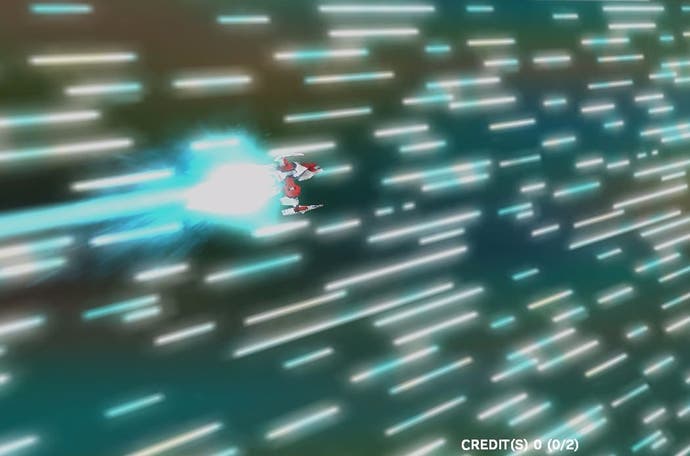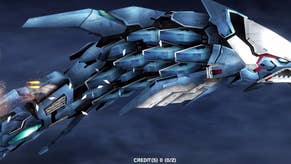Dariusburst: Chronicle Saviours review
Something fishy.
Sometimes we really do get everything we want for Christmas.
Darius was a horizontal scrolling shoot-em-up first released in arcades in 1986. An IP with a noteworthy history, it was considered creatively groundbreaking at the time, and its mainstay of experimental music, ethereal styling, and marine themed nemeses has remained unique in the 30 years since.
Dariusburst - the first new entry since 1997's G-Darius - debuted on PSP in 2009 before being overhauled as a very different, thoroughly impressive arcade game that upheld the series legacy of multi-monitor displays and vibrating seats. After an EX revision in 2011 and a host of content updates via Taito Japan's online Netsys operation, it's been been four years of shoot-em-up diehards swearing the game would never make it to home console. Yet here it is.
Dariusburst: Chronicle Saviours (notably using the latter noun's correct British English spelling) is now available on Steam and PS4 as a digital download and in physical format for the PS Vita. Unquestionably the ultimate version of the game, the package doesn't just feature everything from the arcade's original and EX releases, including Chronicle mode's head-spinning 3000 stage variations, but comes with an all-new CS mode to boot. The four-player option that made the arcade so special is maintained both locally and online, allowing you to join aptly named 'cabs' and take up the mantle with a band of co-heroes. This is a necessity for Chronicle mode, which was never intended to be beaten in its entirety by a single player.

The game's format is the same as ever: you steer a small but deadly spacecraft through horizontal scrolling stages filled with enemies, obstacles and a generous helping of power-ups, before facing off against one of the Belser army's chief guardians. Where the older titles were more methodical, this speeds everything up, its strip of widescreen regularly bloated by impressive schools of cannon fodder. Although the graphical design is now almost entirely space opera, with galaxies, deep-space outposts and cloud-sheathed planets comprising the bulk of its aesthetic, the series superb audio-visual enterprise and enduringly characteristic sea-life thematic remains intact.
Where predecessor G-Darius's leading novelty was the capture ball, Chronicle Saviour is anchored around the Burst Unit: a highly versatile, rechargeable laser cannon that can either be expended in a powerful attack or detached from the craft and wielded independently. Though the latter property was added as a gimmicky afterthought, according to director Junichi Kashiwagi, it's now the game's key element, allowing the laser to be angled freely for use as a shield, for scything through curtains of enemies, or to capitalise on your score multiplier. Needless to say, once you have an understanding of the cannon's subtleties the scope for strategy is enormous. Will you use it to tear off pieces of Mirage Castle's mecha-armour, or camp behind it while you pummel away at the porcupinefish's heart? Will you expend it on a stage's brief mid-boss or throw it out high, blading across the screen to incinerate an avalanche of meteors? Alternatively, adversaries like Golden Ruler demand you use it as a bridge to cross safely to the opposite side of the screen, and - inspired by Taito's own G-Darius and Metal Black - bosses can be engaged in a deadly laser duel that will boost your power if timed right.
There are nine ships to choose from with enough variation to satisfy a whole range of player preferences. Representing different parts of the Darius chronology, some are stripped back expert ships buoyed with tweaked agility and fire rates, while others boast unique secondary weapons that reap massive score multipliers. The Gaiden ship even comes packing the iconic black hole bomb from Darius Gaiden and it's as gloriously fun to detonate as ever.

DBCS's size is impressive, to the point where newcomers may find it difficult to know where to start. The Arcade option features 24 stages across Original and EX (expert) maps, where you're tasked with clearing three stages of your choice, optionally altering your route after each boss encounter as desired. This mode displays in a native 32:9 aspect ratio and is subsequently letterboxed, meaning anything smaller than a 13" display may be an eyestrain (and playing on the Vita, the text is almost indecipherable.) Maintaining the correct aspect ratio over an unsanctimonious crop is a necessity, and the sense of scale works beautifully on the right setup. For true justice, there's even an option to replicate the arcade display by linking two monitors together. Dim the lights and the only thing you'll be short of are a few warning lights and a rumbling seat - although fighting mega-boss Great Thing usually takes care of the latter, if you catch my drift (or yours, as the case may be).
New CS mode is a nice addition if you prefer a gourmet platter of challenges, and is the only option optimised for a normal 16:9 display. Much like Chronicle mode, in which you liberate star systems by felling trials under varying conditions, CS branches out over a 200 stage map with missions ranging from straightforward assaults to defence and time attack scenarios. It also makes an attempt to guide you through the series overarching story from various perspectives, but unless you're a real fanatic most of any narrative continuity will be difficult to glean from the spartan text-based subtitles. As with Chronicle mode's 3000 stages, CS is guilty of liberal copy-pasting, and this may discourage some to mine its watery depths. Those who go in for the grind will be treated to new enemies, bosses, audio tracks and a healthy amount of Darius homage for series stalwarts. CS's shop system allows you to spend points earned in stages on unlocking new ships, upgrades and power-ups, with pragmatic spending required for mammoth boss-rushes and ultimately Gigantic Bite - a new CS-only boss confirmed as the toughest in Darius history.
However you choose to play, whether all or in part, alone or in a group, DBCS is a product of exceptional grace. Cinematic and grandiose, the hypnotic flow of its stages and the dynamism of your weaponry is only upstaged by its set-piece bosses. From giant mechanised crabs and hulking sea turtles to formidable stingrays, swordfish and golden lobsters, each battle is positively majestic. When you're in the heat of it, pyrotechnics blistering all around, firing off the Burst Unit and tripping through laser belts being spewed in concentric clusters, the adrenaline only subsides when shafts of light spill from between your foe's ceramic scales and they go up in a thundering ball of flame.

And all this is conducted symphonically to Zuntata's godly soundtrack, an avant-garde masterpiece of a composition that develops in harmony with the on-screen action. Arranging traditional instruments and heavy bass with choir vocals, sea-life samples and radical progressions, it occasionally hits as high a brow as video game music has the right to achieve. Only Freedom - a token track created for Chronicle Saviours that opens CS mode's first stage - is a smudge on an otherwise comprehensive piece of work, the vocalist caterwauling over what can only be described as unremarkable J-muzak.
It's sad that Dariusburst: Chronicle Saviours will merely be a blast from the past for most people. Shooting games - or shmups, depending on your preferred designation - are as much fun to master now as they were thirty years ago, except these days the genre's time-honoured arcade discipline of clearing a 25-minute campaign without using a continue is regrettably misunderstood by all but the dedicated. If you're questioning the unusually high price tag - and most people are - it's because Taito know they can only make the bulk of profit from gamers with an existing affinity for the genre. While that's understandable to a degree, the PS4's £50 price tag - currently double that of Steam - is frankly unacceptable for a digital download.
On that note, perhaps Dariusburst: Chronicle Saviours should be considered something special rather than something expensive. It's not only beautifully designed, with a balanced learning curve, absorbing scoring pursuits, and an engaging sense of risk and reward, but the Burst Unit alone opens up whole new dimensions of approach. Being a meticulous reproduction of a once out-of-reach arcade experience doesn't guarantee it mass appeal, but there's magic awaiting those who can commit to felling three brief stages on a single credit. Given the shape of today's gaming landscape and the tastes of its patrons, however, it's not a title that can be easily recommended to everyone. Considering that it's the best thing since tuna sashimi, I really wish it could be.












